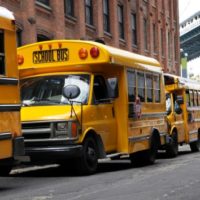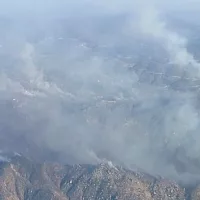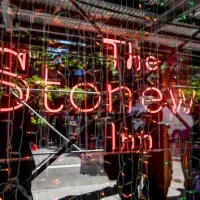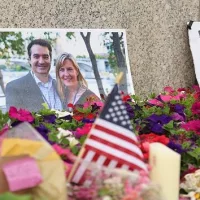
Lisa-Blue/iStockBy PRIYA AMIN, DR. ALEXIS E. CARRINGTON and RAMIE FATHY, ABC News
(NEW YORK) — The nation’s largest school district will shut its doors on Thursday as novel coronavirus rates in New York City creep upward and case numbers climb across the country. Students across the city’s public school system will now transition to remote learning — sparking confusion and frustration amongst the city’s parents, teachers and students.
Meanwhile, even public health experts questioned the move, pointing out that schools have not proved to be likely transmission hotspots and that the city’s bars and restaurants are more likely drivers of coronavirus spread.
Mayor Bill de Blasio made the final call Wednesday afternoon, prompted by the city reaching a 3% test positivity rate over a seven-day rolling average — a conservative threshold measured against the rest of the country, which de Blasio set as the watermark amid the summer surge.
“Today’s a tough day, but this is a temporary situation,” de Blasio said Wednesday in an afternoon press conference that occurred five hours after his briefing was initially scheduled. “We all are feeling very sad about this decision because so much good work has been put into keeping the schools open,” the mayor said, adding, “our schools will be back.”
“But we set a very clear standard and we need to stick to that standard,” he added.
The district was among the first to reopen for in-person learning. And for eight weeks, about 300,000 of the city’s 1.1 million students navigated a mixed schedule of in-person and at-home learning.
The call to shutter schools provoked an uproar from the city’s teachers, parents and students left to contend with the whiplash — and impact to scholastic curricula as well as daily lives — for what they viewed as an arbitrary circuit breaker, rather than a safety switch.
“This should have steps, not just immediately shut down,” said Nora Balla, a third grade general education teacher at Brooklyn Charter School in District 14. “We’re already feeling the stress and we see the kids slipping badly.”
“I was really just in shock because I feel like school just opened, and I was already getting used to going to school, waking up, getting used to wearing masks,” eighth grader Brianna Bernal told WABC-TV.
Fomenting the confusion is the wide margin between the city positivity rate and that of New York City schools which, as of Monday, held at 0.23 percent with more than 140,000 students and staff tested.
The positivity rate varies in different neighborhoods, being slightly higher on Staten Island and the Bronx and lower in Manhattan and Queens. Additionally, the state and the city use different metrics to measure the coronavirus infection rate. Currently, by state measure, the city’s seven-day rolling average is 2.5%.
Experts emphasized the mixed signal offered by schools being closed while other venues remain open — including restaurants and bars — which the Centers for Disease Control and Prevention has reported to be common sites of transmission.
“Scientifically, there’s nothing magical about 3 percent,” Dr. John Brownstein, an epidemiologist at Boston Children’s Hospital and ABC News contributor, told ABC. “It’s a threshold to evaluate important decisions, but we shouldn’t be so binary with these data because it’s so susceptible to changes in behavior and clearly those percentages can be changed with other policy decisions.”
“Indoor dining, informal gathering is another contributor. We’re not seeing schools being big contributors to the rise,” Brownstein said.
“I think we can close down other businesses that are contributing to the high infection rate, as opposed to school infection rate, first,” Balla told ABC News.
In what was once the epicenter of the COVID-19 health crisis, New York toiled over several months of stringent health mitigations to work its case rate down. It was the first big city in the country to reopen school buildings which, at least in part, offered a shred of normalcy in an otherwise unprecedented time.
Thursday’s closure indicated a concerning and confusing new phase in the combat against coronavirus when, in spite of fears to the contrary, public schools have not appeared to be widespread incubators of the virus.
In other states across the country, positivity thresholds for school closures vary widely: Arizona uses a 7% cutoff, while Iowa employs 15%.
The World Health Organization recommends a school closure threshold of a 5% positivity rate.
As the idea of school closures lingered ahead of the final call, New York Gov. Andrew Cuomo suggested reconsidering the 3% cut-off.
“Wouldn’t you want to keep a student in a 1% [positivity rate] school rather than a 3% street?” he asked at a Saturday briefing.
“It’s sad, there are deep impacts on the social-emotional development for young kids — especially really young kids,” a Brooklyn-based preschool, special education teacher and mother of three, said. She requested anonymity amid a tense time for teachers, noting it’s not an easy time for parents either who are “having to take on a lot of their child’s education.”
Dr. Julia Nunan-Saah and Dr. Amanda Wagner, two clinical neuropsychologists at the Learning and Development Center at the Child Mind Institute, told ABC News that students “thrive on the relationships and support they receive” from teachers and peers alike through in-person schooling, as compared to their limit with remote learning. Students already struggling socially may suffer from developmental skill regression with remote-only learning where there is “less opportunity to practice socialization.”
Nunan-Saah and Wagner also noted, issues of domestic violence and child abuse may present a further challenge to intervene when no campus refuge is available when remote learning’s isolation “may make it more difficult for teachers to notice” some of those behaviors.
Experts note the negative impacts may ripple through households, from the students’ education and home health, to parents’ ability to juggle new, high-pressured roles and making it especially difficult for families on the lower socioeconomic end of the spectrum already bearing the brunt of the pandemic.
Families already in difficult financial straits getting walloped by the pandemic now have less cushion to fall back on in the case of layoffs. They also have a harder time affording child care and have less flexibility to balance work and makeshift homeschooling.
The Family Homelessness Coalition urged the city not to forget about the 114,000 homeless children at high risk of falling behind.
“For the 114,000 homeless children in New York City, school closures aren’t just frustrating — they are a danger to their well-being,” the Coalition said in a statement. “For a child living in shelter, temporary housing, or doubled up, remote learning is hardly an option. Many lack basic necessities like Wi-Fi access, a working tablet or even physical space to study and learn. New York City cannot stand idly by as our most vulnerable children fall even further behind.”
It’s an inequity not lost on some New York parents who have noted that the public schools are now closed, not the private ones.
“My daughter is going to wake up in a city, where the children in our neighborhood that attend private schools, that attend Catholic schools and attend charter schools will still have their schools open, and my daughter’s will be closed,” Karen Vaites, a Manhattan parent, told WABC. “And that’s just wrong. It’s inequitable and it’s wrong.”
Some experts suggest using a more holistic approach to making decisions about when schools should close, calling upon a variety of metrics to inform insight like the number of hospitalizations rather than the generic rate which may not tell the whole story.
“It makes it challenging to rely on one measure,” Brownstein said. “It doesn’t take into account the nuances in the community. You don’t want to just solely rely on [positivity rate] because it depends on the testing population.”
“I want to remind everyone that is listening here today that school is still in session,” New York City Schools Chancellor Richard Carranza said at Wednesday’s briefing, emphasizing, “we are looking at this as a temporary closure.”
Copyright © 2020, ABC Audio. All rights reserved.















